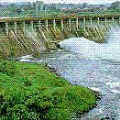南非,開普敦
12, 1, 2000(ENS)
世界大壩委員會(World Commission on Dams)在本月初一份綜合報告中表示,因應水力發電所需而建造的許多大型水壩,其蓄水庫確實會釋出溫室效應氣體。這項發現和普遍假設下,水庫溫室氣體排放幾乎為零的說法相互牴觸。
該委員會表示:「針對北半球的溫帶地區以及熱帶地區,總共三十座水壩的測量已經完成,結果顯示它們釋出溫室效應氣體已有數十年之久。」
位於南非開普敦(Cape Town)的世界大壩委員會是由集合十二位專家的國際團隊所構成。這個由援助機構、產業界、政府及非政府組織所籌設、贊助的獨立智囊團,旨在檢視該會所稱「全世界各水壩所造成的各種好、壞與醜陋的影響」。該委員會成立於1998年,受命進行研究、評論,並撰寫有關水庫、水源及能源發展計劃方面、最具權威與獨立性的綜合交叉檢驗報告。

卡德爾阿斯摩(Kader
Asmal),世界大壩委員會主席,於11月16日在倫敦簽署一份結論報告。(照片授權:世界大壩委員會)
這份名為「大壩與開發:一個全新的決策架構」的結論報告,於11月17日提交聯合國,報告中指出:「所有位於溫帶及熱帶地區的大壩以及天然湖泊,都已經被測出有溫室效應氣體釋出的情形」。
世界大壩委員會的這項發現,其資料來源主要是根據來自加拿大、巴西、蓋亞那以及芬蘭等國家有關這個主題的最新研究報告。
該委員會表示,北半球的北部氣候區如加拿大及斯勘地那維亞,目前的研究資料顯示該區水力發電蓄水庫所釋出的溫室效應氣體為數甚低。以巴西的十件水壩研究案為例,各水壩之溫室氣體排放量的最大差距高達500倍之多。其最低值與加拿大境內水庫及湖泊的測值相近,而最高年釋出量估計值已達火力發電廠的程度,即使在作決定性的比較之前,這些電廠的使用年限評估及淨釋出量的計算都必須要先行確定。

世界上最大的蓄水大壩:位於非洲烏干達(Uganda)的歐旺瀑布大壩(Owen
Falls Dam)。位於該大壩的水力發電站提供該國大部分的電力需求,也提供部分肯亞(Kenya)境內的電力。(照片授權:泰國凱西薩特大學工程學院)
該委員會表示,單憑流域中的生物量並不能解釋氣體的釋出現象。根據該委員會的研究報告,「碳是由整個流域的上游流入水庫,況且流域中其它的開發或資源管理的進行也可能在未來增加或減少碳進入水庫。」
該委員會建議,不能制式地假定水力發電就會比那些火力發電廠排放較少的溫室效應氣體。淨釋出量應該以個案為基礎來計算。
根據國家水力發電協會(National Hydropower
Association, NHA)的資料,水力發電提供美國再生能源電力的80%,並供應將近全球五分之一的用電。在美國境內七萬五千座大壩中,不到3%的比例設有水力發電站。該協會為一個工業組織,代表61%的美國國內非聯邦組織的水力發電量。
國家水力發電協會表示,不需建壩阻水而有利於水力發電的構想已在發展當中。正因為不需建水庫,利用流動性水流的方式來發電,也許就不會產生溫室效應氣體。
國家水力發電協會表示,利用潮汐或河水流動發電、而不需大壩蓄水的構想,已進入田野測試階段。這些水底下的裝置能在水流流速三節或更高的時候串聯發電,產生300千瓦(300,000
瓦) 至300百萬(300,000,000)瓦特的電力,並且不論串聯與否均能發揮功用。該協會表示:「這樣的供電較其他間歇性再生能源更具成本競爭力。」

加拿大安大略省多倫多Humber河上的Clairville大壩及其集水區。(照片授權:加拿大環境協會)
在加拿大,水力發電佔總供電的62%,加拿大水力發電協會(Canadian
Hydropower Association)結合國際水力發電協會(International
Hydropower Association)及國際電力組織(International Energy
Agency),共同撰寫一份名為「水力發電與全球能源的未來」之報告於11月21日發表。該報告中宣稱水力發電「提供主要的乾淨和再生能源,並且在未來全球多樣化能源中扮演關鍵性角色。」
加拿大水力發電協會執行長皮耶爾佛丁(Pierre
Fortin)說:「要減少溫室效應氣體排放又要能繼續滿足不斷成長的能源需求的一個好辦法,就是擴大發展如水力發電這種乾淨、再生能源。」
世界大壩委員會並非指責所有大壩蓄水庫皆為溫室效應氣體的排放者。該委員會要求將「清楚地評估未來溫室效應氣體的淨排放量」列入評估大壩使用年限的有效比較項目當中。
在水力發電項目方面,該委員會提出指導方針來協助這類評估工作,包括測量自然環境集水區前置蓄水量中的碳流,並評估在大壩建築完成之後這些因子會如何變化。
該委員會呼籲要進行更多的研究工作,以增進目前對於溫室效應氣體在現有流域及水庫中循環流動的瞭解,並改進在新建水庫計劃中對於溫室效應氣體排放量的預測能力。
世界大壩委員會的十二位委員代表了包括業界工程師、學界人士、政界活躍份子及管理者的專業知識。若要得知更多有關於該委員會成員的訊息,請連往http://www.dams.org/about/commissioners.htm
全文及圖示詳見: http://ens-news.com/ens/dec2000/2000L-12-01-01.html
版權歸屬 Environment News Service 環境信託基金會 (陳均輝
譯,施淑芬 蔡麗伶 審校)
中英對照全文:http://news.ngo.org.tw/issue/climate/2001/sub-cc01010901.htm
|
|
CAPE TOWN, South Africa,
December 1, 2000 (ENS)
The reservoirs of many large dams built to generate hydroelectric power do produce greenhouse gases, the World Commission on Dams says in a comprehensive report issued earlier this month. This finding is in contrast to the widespread assumption that such emissions are zero or negligible.
"Greenhouse gases are emitted for decades from all 30 dam reservoirs in the boreal and tropic regions for which measurements have been made," the commission says.
The World Commission on Dams, based in Cape Town, South Africa is made up of an international team of 12 experts. It is an independent think tank set up and financed by aid agencies, industry, governments, and non-governmental organizations to look at what the commission calls "the good, the bad and the ugly impacts of dams around the world." Established in 1998, the Commission's mandate is to research, peer review and write the most independent, authoritative and comprehensive cross examination of dams and water and energy resource development ever undertaken.
Chairman of the World Commission on Dams Kader Asmal signs the final report at the London launch November 16. (Photo courtesy World Commission on Dams)
In its final report, "Dams and Development: A New Framework for Decision-making," presented to the United Nations on November 17, the commission writes, "All large dams and natural lakes in the boreal and tropical regions that have been measured emit greenhouse gases."
The commission's findings were informed by the most recent research on this issue in Canada, Brazil, French Guyana and Finland.
In northern boreal climates like Canada and Scandinavia available studies so far suggest that emissions from hydropower reservoirs are low, the commission says.
For Brazil, of ten dams studied, emissions vary from dam to dam with a 500-fold difference between lowest and highest. The lowest emissions are on similar levels to Canadian lakes and reservoirs, the highest annual gross emissions reach the ranges of thermal energy plants, although life cycle assessment, and determination of net emissions, is needed before definitive comparisons can be made.
World's largest storage dam, Uganda's Owen Falls Dam. The hydroelectric station at the dam supplies most of the electricity requirements of Uganda, and parts of Kenya. (Photo courtesy Faculty of Engineering, Kasetsart University, Thailand)
The flooded biomass alone does not explain the observed gas emissions, the commission says. "Carbon is flowing into the reservoir from the entire basin upstream, and other development and resource management activities in the basin can increase or decrease future carbon inputs to the reservoir," according to the commission's report.
The commission advises that hydropower cannot be automatically assumed to emit less greenhouse gas than the thermal alternatives which use fossil fuels to generate power. Net emissions should be established on a case by case basis.
Hydroelectricity provides for 80 percent of all the renewable power generated in the United States, and provides about one-fifth of the world's electricity. Of the 75,000 dams in the U.S., less than three percent have hydroelectric generating stations, according to the National Hydropower Association (NHA), an industry oranization representing 61 percent of non-federal hydroelectric capacity in the United States.
Ideas for generating electricity with water but without building dams to hold back rivers in reservoirs are in development, according to the NHA. Because no reservoirs are created, a free flow method for generating power may not create greenhouse gas emissions.
The NHA says an idea that is ready for field testing would use tidal or river currents to generate electricity without impounding water behind a dam. Requiring a current of three knots or better, these submerged units would be clustered together to generate from 300 kW to as much as 300 MW. They could be used either on or off the grid, providing power that is "cost competitive with other intermittent renewable energy sources," the association says.
Clairville Dam and Reservoir, Humber River, Toronto, Ontario, Canada (Photo courtesy Environment Canada)'
In Canada, hydropower represents 62 percent of the electricity production. The Canadian Hydropower Association joined with the International Hydropower Association and the International Energy Agency in writing a report issued on November 21, "Hydropower and the World Energy Future." The report declared hydropower to be, "the main supply of clean, renewable energy, and as an energy that will play a key role in the future world energy mix."
"One way to reduce greenhouse gas emissions while continuing to supply the growing energy demand is to increase the development of clean, renewable energy sources such as hydropower," says Canadian Hydropower Association executive director Pierre Fortin.
The World Commission on Dams does not condemn all dam reservoirs as greenhouse gas emitters. The commission calls for "explicit assessment of future net greenhouse gas emissions of a project" through full life cycle assessments to compare available options.
For the hydropower option, the commission proposes guidelines to assist in these assessments. These include measuring carbon flows in the natural pre-impoundment watershed and assessing how these will change following dam construction.
The commission calls for further research to improve current understanding of how greenhouse gases cycle within existing basin and reservoirs and to improve capacity to predict future net emissions of new reservoir projects.
The 12 commissioners who make up the World Commission on Dams represent a wide range of interests including commercial engineers, academics, activists and administrators of government agencies. To learn more about the commissioners, visit:
http://www.dams.org/about/commissioners.htm
http://ens-news.com/ens/dec2000/2000L-12-01-01.html
|
